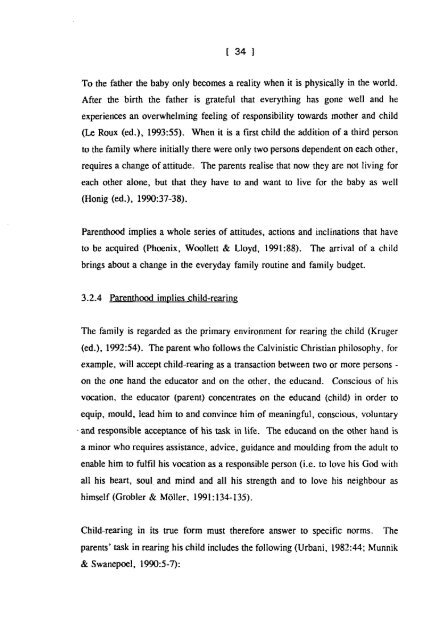parents and principals as partners in creating a culture of learning
parents and principals as partners in creating a culture of learning
parents and principals as partners in creating a culture of learning
Create successful ePaper yourself
Turn your PDF publications into a flip-book with our unique Google optimized e-Paper software.
[ 34 1<br />
To the father the baby only becomes a reality when it is physically <strong>in</strong> the world.<br />
After the birth the father is grateful that everyth<strong>in</strong>g h<strong>as</strong> gone well <strong>and</strong> he<br />
experiences an overwhelm<strong>in</strong>g feel<strong>in</strong>g <strong>of</strong> responsibility towards mother <strong>and</strong> child<br />
(Le Roux: (ed.), 1993:55). When it is a first child the addition <strong>of</strong> a third person<br />
to the family where <strong>in</strong>itially there were only two persons dependent on each other.<br />
requires a change <strong>of</strong> attitude. The <strong>parents</strong> realise that now they are not liv<strong>in</strong>g for<br />
each other alone, but that they have to <strong>and</strong> want to live for the baby <strong>as</strong> well<br />
(Honig (00.), 1990:37-38).<br />
Parenthood implies a whole series <strong>of</strong> attitudes, actions <strong>and</strong> <strong>in</strong>cl<strong>in</strong>ations that have<br />
to be acquired (Phoenix, Woollett & L1oyd, 1991:88). The arrival <strong>of</strong> a child<br />
br<strong>in</strong>gs about a change <strong>in</strong> the everyday family rout<strong>in</strong>e <strong>and</strong> family budget.<br />
3.2.4 Parenthood implies child-rear<strong>in</strong>g<br />
The family is regarded <strong>as</strong> the primary environment for rear<strong>in</strong>g the child (Kruger<br />
(ed.), 1992:54). The parent who follows the Calv<strong>in</strong>istic Christian philosophy, for<br />
example, will accept child-rear<strong>in</strong>g <strong>as</strong> a transaction between two or more persons <br />
on the one h<strong>and</strong> the educator <strong>and</strong> on the other. the educ<strong>and</strong>. Conscious <strong>of</strong> his<br />
vocation, the educator (parent) concentrates on the educ<strong>and</strong> (child) <strong>in</strong> order to<br />
equip, mould, lead him to <strong>and</strong> conv<strong>in</strong>ce him <strong>of</strong> mean<strong>in</strong>gful, conscious, voluntary<br />
-<strong>and</strong> responsible acceptance <strong>of</strong> his t<strong>as</strong>k <strong>in</strong> life. The educ<strong>and</strong> on the other h<strong>and</strong> is<br />
a m<strong>in</strong>or who requires <strong>as</strong>sistance, advice, guidance <strong>and</strong> mould<strong>in</strong>g from the adult to<br />
enable him to fulfil his vocation <strong>as</strong> a responsible person (i.e. to love his God with<br />
all his heart, soul <strong>and</strong> m<strong>in</strong>d <strong>and</strong> all his strength <strong>and</strong> to love his neighbour <strong>as</strong><br />
himself (Grobler & M611er, 1991:134-135).<br />
Child-rear<strong>in</strong>g <strong>in</strong> its true form must therefore answer to specific norms. The<br />
<strong>parents</strong>' t<strong>as</strong>k <strong>in</strong> rear<strong>in</strong>g his child <strong>in</strong>cludes the follow<strong>in</strong>g (Urbani, 1982:44; Munnik<br />
& Swanepoel, 1990:5-7):

















